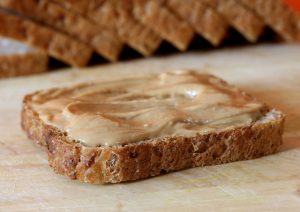 Peanut butter is the favourite spread of millions of people in the world. Its excellent taste, its creamy texture and its unique way of sticking to the roof of your mouth before melting are good enough reasons to eat huge amounts of peanut butter. Well, if you are allergic to peanuts or if you don’t like their taste, you won’t be able to enjoy peanut butter.
Peanut butter is the favourite spread of millions of people in the world. Its excellent taste, its creamy texture and its unique way of sticking to the roof of your mouth before melting are good enough reasons to eat huge amounts of peanut butter. Well, if you are allergic to peanuts or if you don’t like their taste, you won’t be able to enjoy peanut butter.
What is Peanut Butter, Anyway?
Peanut butter is nothing else than peanuts, roasted or not, ground until they become a paste and put through diaphragm pumps. However, you have to keep in mind that many peanut butters available on the market may contain sugar, vegetable oils, trans fat or various other additives. If you want to do yourself a favour, choose real peanut butter. It should contain only peanuts and perhaps a pinch of salt. If you go for the healthy choice of peanut butter, you’ll enjoy the same health benefits as you do when eating peanuts.
It Makes a High-Quality Protein Source
Peanut butter is a good energy source that provides you with the right amounts of all three macronutrients. Here’s what a 100g serving of peanut butter contains:
– Carbohydrate: 20g (13% of total calories), out of which 6g is fibre.
– Protein: 25g (15% of total calories), higher than the protein content of most plant foods.
– Fat: 50g (72% of total calories).
Although peanut butter is rich in protein, it contains very little of the essential amino acid methionine. Peanuts belong to the legume family, together with peas, beans and lentils. Legume protein has way less methionine and cysteine than animal protein.
It is a Low-Carb Food
Pure peanut butter contains only 20% carbohydrates, thus being one of the ideal foods for a low-carb diet. It also triggers a very low rise of blood sugar levels, being, therefore, one of the best choices for people with type 2 diabetes. According to an observational study, female subjects eating peanut butter 5 times a week or more reduced their type 2 diabetes risk by 21%.
It is Rich in Healthy Fats
A 100g serving of peanut butter contains 588 calories, due to its high fat content. Despite this, eating peanut butter in moderation can work very well for those on a weight-loss diet. About 50% of the fat in peanut butter is oleic acid, which is a healthy type of monounsaturated fat. This is the same compound as in olive oil. Peanut butter also contains a certain amount of linoleic acid, one of the essential omega-6 fatty acids found in most vegetable oils. According to some studies, a high intake of omega-6 fatty acids, as opposed to omega-3, may increase the risk of chronic disease and the level of internal inflammation.
Peanut Butter is a Good Source of Vitamins and Minerals
Peanut butter contains a wealth of nutrients. A 100-gram portion supplies the following nutrients (4):
– Vitamin E: 45% of the RDA (recommended dietary allowance).
– Vitamin B3 (Niacin): 67% of the RDA.
– Vitamin B6: almost 33% of the RDA.
– Folate: 20% of the RDA.
– Magnesium: almost 40% of the RDA.
– Copper: almost 25% of the RDA.
-Manganese: almost 75% of the RDA.
It also contains decent amounts of vitamin B5, biotin, zinc, selenium, potassium and iron.
Conclusions
Peanut butter has lots of advantages, but also a few drawbacks. It contains a fairly high amount of nutrients and it is an excellent protein source. It also contains fibre, vitamins and minerals, although they may not seem that important when thinking about the high number of calories. At the same time, peanut butter is a source of aflatoxins, which are known to cause long-term harmful effects on the body. These being said, you can eat peanut butter occasionally, but only in small amounts. Avoid making it one of your main food sources, though. The biggest problem of peanut butter is its addictive nature. Since it has such a delicious taste, you can indulge every now and then, without having to worry about its negative effects. It is definitely much healthier than junk food, sugary drinks and other highly processed foods that taste good and are as addictive.